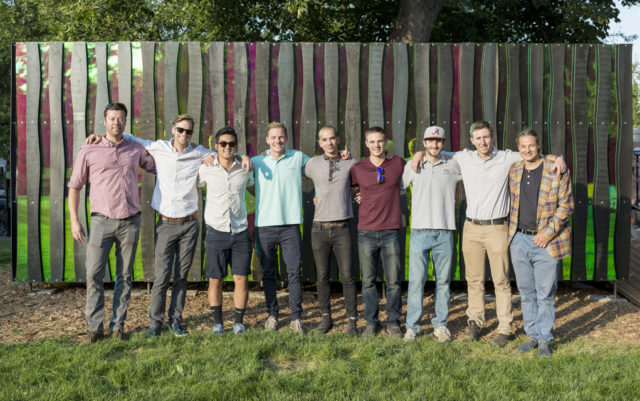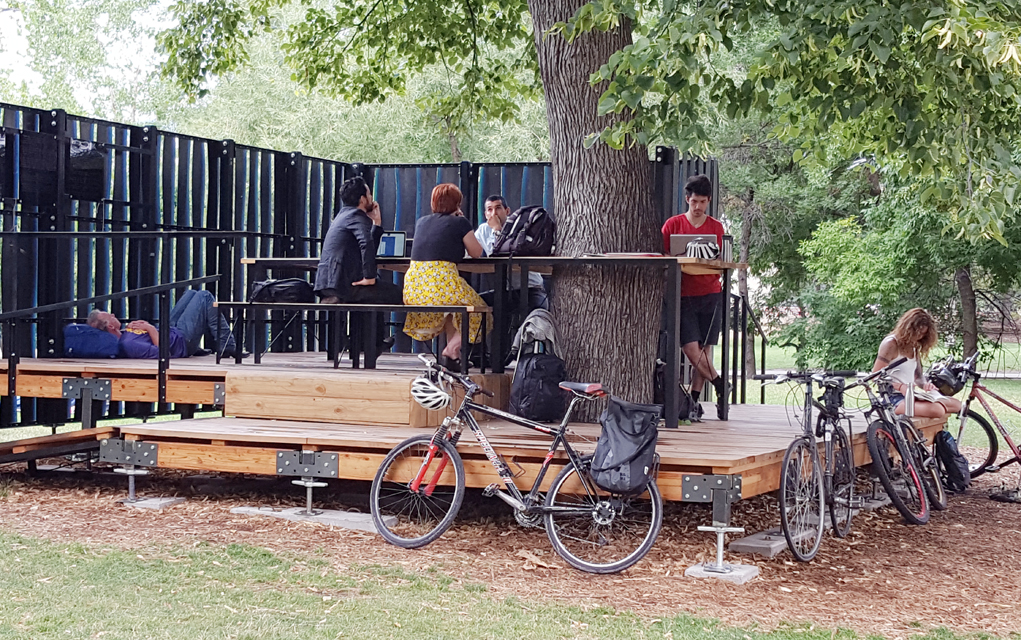
In Civic Area Park, just in front of the Boulder Museum for Contemporary Art (BMoCA), grows a large American linden tree with fissured bark and a leafy canopy. Once an urban tree that offered shade on a hot day or a place to lean at the farmers’ market, it is now surrounded by a modern wooden platform with three walls encircling the trunk, covering its visible root system. It is now TREExOFFICE, one of the pieces included in BMoCA’s ongoing exhibition DESIGNxBOULDER, replete with free Wi-Fi courtesy of the City of Boulder. And no, this isn’t the work of corporate interests or developers, but of artists, design students and environmental stewards.
The public art installation is inspired by The Tree That Owns Itself in Athens, Georgia, where the tree is its own landlord and stands for the rights of nature. According to local historians, the tree was deeded to itself in the will of its former owner, Colonel William Henry Jackson, who loved the tree and desired its protection beyond the confines of his lifetime.
It is in a similar ethic that TREExOFFICE grants ownership of the office to the tree. The space is available for public use or can be rented out through the City of Boulder for a fee. All of the proceeds go to Boulder Parks and Recreation to fund the maintenance and upkeep of the linden.

Although the juxtaposition of nature and technology creates tension, TREExOFFICE is at its core a collaborative project that promotes a new generation of sustainability only possible through a coordinated effort of many partners. The project is led by artist Natalie Jeremijenko, with input and support from BMoCA, EcoArts Connection, the City of Boulder and design students from the University of Colorado Boulder and funding from the National Endowment for the Arts.
“DESIGNxBOULDER is a reimagination of our place in systems,” Jeremijenko said at an artist talk on the main platform of the installation. “We tend to imagine solutions as technology triumphing over nature, but we need to recognize the mutual existence of the two. We need to redesign the infrastructures of society so that we can do more with less and create a framework of health. This is a transpersonal challenge as well as a transorganizational challenge as we work to incorporate science with nature, together.”
Marda Kirn, executive director of EcoArts Connection, acknowledges the odd tension introduced by the installation.
“If you want to go as far as you can go, well, it would be better if there were no humans at all,” she says with a laugh. “But we are also creatures and so we need to be able to learn to live more peaceably in and with nature. The idea of bringing together technology and the arts, engineering and the humanities is at the core of what we try to do [at EcoArts Connection] because you really need both to solve some of these deep environmental issues.”
Jeremijenko’s interest is in the human capacity to respond to the global climate crisis through focus on human ecosystems in urban settings. But rather than tack comfortable solutions onto existing infrastructures, she seeks a total re-invention of systems through a marriage of nature and science.
Which is how Marcel de Lange, architect and instructor at CU’s program in environmental design, became involved. In a praxis course focused on using emerging architectural and construction technologies to promote a healthier world, de Lange led students at CU in the design and build of TREExOFFICE.
“I care enormously about tree hugging and all of that, but ultimately I care about design and fabrication,” de Lange says. “My core expertise is the nexus of fabrication technique and new technologies like 3-D printing that are slowly working their way into construction, much of which is really old school with a lot of waste and inefficiency. I am interested in working with students to explore how we can utilize these technologies to maximize efficiencies and ultimately export the technologies to poorer communities.”
Inside BMoCA are two other installations by Jeremijenko, addressing the ways technology and art can combine to create more cooperative systems.
“FARMACY: AgBag Flower Façade” hangs on the front of the building, made of repurposed pockets of common construction material filled with soil and air-filtering plants.
The cascading columns of flowers are more than aesthetically pleasing — the installation is designed to mitigate the externalities of urban living. The plant varieties Jeremijenko used have a high Leaf Area Index, which maximizes the pollutants that they remove from the air. Their flowers are good for pollinators as well as being edible and nutrient dense. Importantly, the productive capacity of the AgBags supplement local agriculture but do not pose as competition to local farmers who depend on delicate local economies to survive.
In the upstairs gallery of BMoCA, Jeremijenko designed a space for local environmentalists and artists to engage in collaborative re-imagining of activism in the Environmental Health ClinicxHIBITION. Like the TreexOffice, the installation is both art piece and workspace. It both highlights and brings together Boulder environmental thinkers, inventors and activists to work together to create a more resilient world.
“This sounds silly, but I think this is about moving away from what we are against and towards love,” says Kirn of EcoArts Connection. “What you want, what you love, what you are attracted to, is powerful. People like Jeremijenko are offering solutions and right now people who have solutions have something that is really important to offer to the world.”














